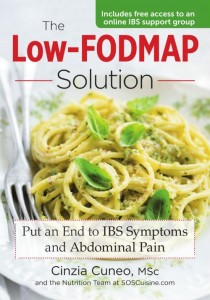The Low-FODMAP Solution
As an Amazon Associate, the Gl Society may earn from qualifying purchases. Which means we may earn a small commission on purchases made through links on this page, with no extra cost to you. Thanks for your support!
Most individuals are able to digest all their favourite foods in comfort, but they might not realize how lucky they are. For the many sufferers of irritable bowel syndrome (IBS), something as simple as digesting food becomes much more difficult. Approximately 13-20% of Canadians suffer from this syndrome. However, because it relates to the gut – a not-so-glamorous topic – it’s rare for people to speak about it openly. The fact that the symptoms (abdominal pain, bloating, diarrhea, constipation) also occur in other conditions means that diagnosis can be challenging in some cases. In addition, the available medications might not be effective at treating all the symptoms for each person, who might need a different combination of medications and other treatments.
These last few years, the media has been pointing the finger at gluten and dairy as the main causes of these digestive symptoms. It might be true that by consuming less bread, pasta, and dairy products, many people tend to feel better and be less bloated. However, we now understand that in some individuals, this improvement is probably not due to the elimination of gluten and dairy products, but, more likely, to the elimination of FODMAPs, which are also contained in wheat and milk. This acronym comes from the term Fermentable Oligosaccharides, Disaccharides, Monosaccharides, And Polyols.
Some individuals digest these carbohydrates poorly. If the body is unable to break these down through processes in the small intestine, then the bacteria in the large intestine finish the job, by fermenting these carbohydrates. This fermentation can cause many unpleasant gastrointestinal symptoms. FODMAPs are present in a large variety of fruits, vegetables, and grains and are widely used in all the world cuisines.
The low-FODMAP diet was developed in 2005 by two Australian researchers from the Monash University in Melbourne: Dr. Peter Gibson, gastroenterologist, and Dr. Sue Shepherd, registered dietitian. Since then, data from several short-term (<6 weeks) controlled clinical trials suggests that a low-FODMAP diet can reduce some gastrointestinal symptoms (i.e., abdominal pain, bloating, excessive gas), compared to no dietary intervention. In March of 2016, the journal Gut published results from a small-scale, single-blinded, randomized controlled study,1 conducted at Queens University, which found that 72% of IBS patients had a marked decrease in abdominal pain and tended to have less abdominal distension with the low-FODMAP diet.
The dietary protocol consists of three phases:
- Elimination phase: The purpose of this phase is to confirm that the gastrointestinal symptoms are caused by FODMAPs. If avoiding the main FODMAP sources for 2 to 4 weeks causes a reduction in symptoms (for some people it may take up to 8 weeks), then FODMAPs might be at least partially responsible. Once intestinal comfort is attained, the next phase might be started.
- Reintroduction phase: The purpose of this phase is to understand which individual FODMAP(s) are problematic. One single type of FODMAP is tested each week, for about 6 weeks. It is very important to identify which FODMAPs are causing the symptoms, to avoid excluding too many foods without a good reason. Many foods that contain FODMAPs are normally beneficial to our health, in particular for the microbiome, hence it is important to add them to our plate.
- Maintenance phase (long-term): The purpose of this phase is to have a varied diet, with no gastrointestinal discomfort. Individuals may add a wide variety of food, including FODMAPs, until symptoms recur.
It is important to understand that this diet does not cure IBS, but it might considerably reduce the symptoms in some individuals, provided you follow it diligently. It is not intended for long-term use.
It is easier to apply this diet with expert help, because the list of foods to avoid is very long and because these foods are widely present in our daily lives. The lists include, among many others, wheat, barley, onion, garlic, milk, apples, and honey. SOSCuisine has recently published a book on this subject: The Low-FODMAP Solution: Put an end to IBS symptoms and abdominal pain!
The first part of this book provides the foundation for understanding the low-FODMAP diet and how to implement it properly. The second part is practical, including healthy low-FODMAP meal plans and 100 easy-to-make and nutritious recipes, with appetizing pictures, which will help you apply the diet hassle-free.
Click here to learn more or purchase The Low-FODMAP Solution on Amazon.

